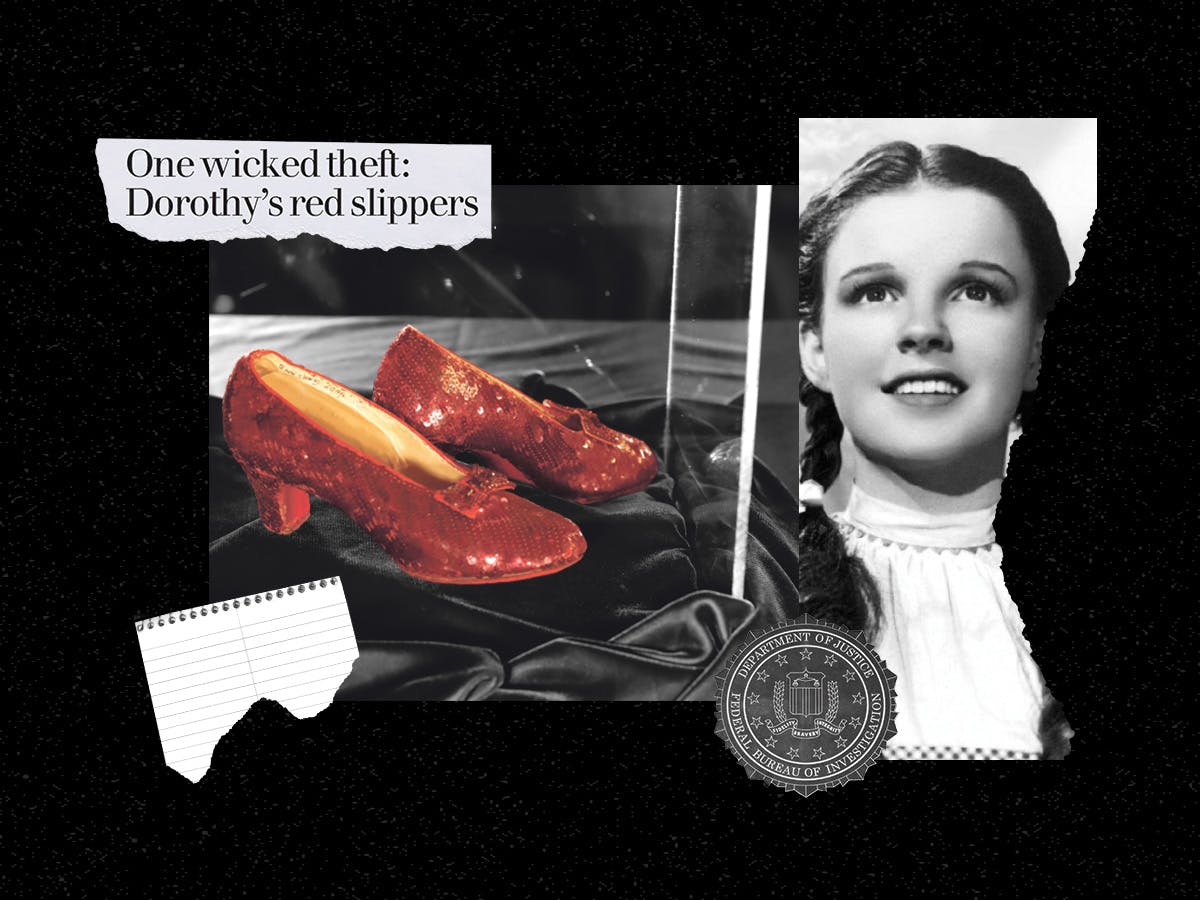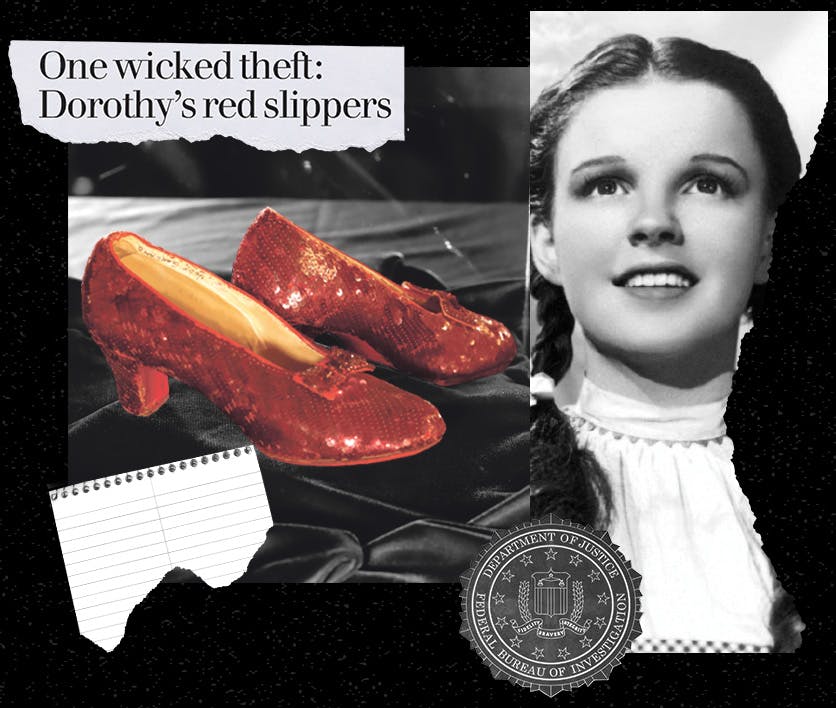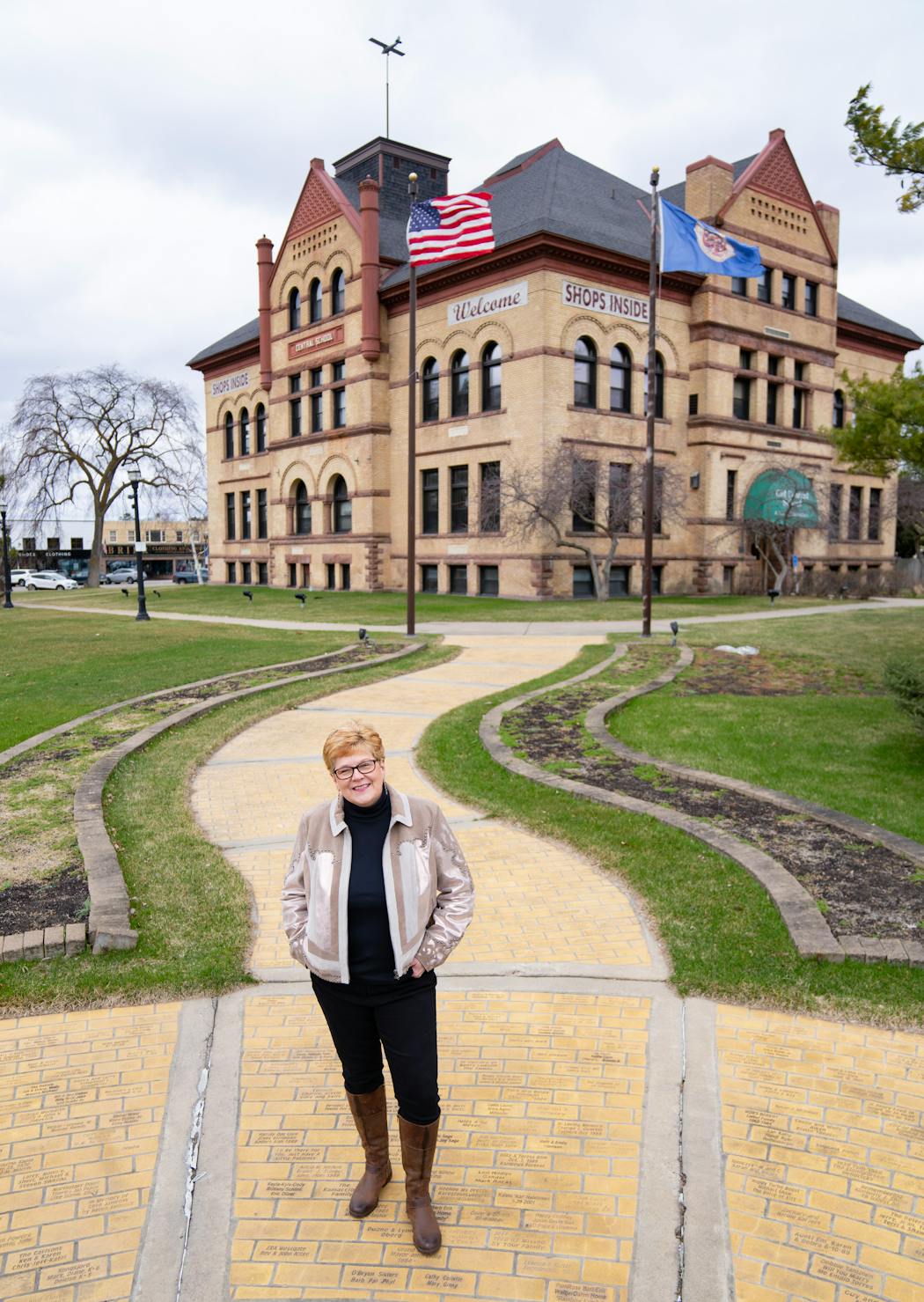Minnesota's heist of the century occurred in an unlikely place: the modest Judy Garland Museum in Grand Rapids.
Sometime after the museum closed on Aug. 27, 2005, a window was smashed and a pair of Dorothy's ruby slippers from "The Wizard of Oz" vanished as mysteriously as the melted Wicked Witch.
The sequin-studded shoes are no mere movie prop. They are, arguably, Hollywood's most iconic memorabilia. And the theft of the cultural treasure — the emblem of one of the country's most-watched films, referred to as America's "Mona Lisa" — shone an unflattering spotlight on Garland's humble hometown.
Museum security had been lax. In the absence of security footage, fingers were pointed and accusations flew. National media likened local police to bumbling Keystone Kops. Divers plunged into an abandoned mine pit in search of the slippers.
Not since the James-Younger gang rode into Northfield has a Minnesota town been so rocked by a theft.
Left in the slippers' shimmering wake were lives complicated, relationships strained and reputations tarnished. Including that of the town itself, which had been unknowingly harboring a career criminal the Coen brothers couldn't have scripted, one who thought the shoes were made of real rubies.
"It seemed everyone, including the PD, was baffled by what appeared to be a very easy lift," recalled Britta Arendt, who edited the local newspaper at that time.
Then, 13 years after the slippers disappeared, they returned out of nowhere, as if they'd simply clicked their magical heels instead of having been nabbed in an FBI sting. It took another five years for a local septuagenarian, Terry Jon Martin, to be indicted and plead guilty, in October 2023.
But the case is far from settled. In fact, there's still enough intrigue to bring a Los Angeles–based documentary crew to town to interview those impacted by the theft (for better or worse), including the reporter who dug up the dirt, the museum head who took the heat, the chief of police and various townsfolk.
Whether locals consider the case with excitement or chagrin, many agree their community has forever changed, no longer likely to be mistaken for its better-known Michigan twin. "Grand Rapids is going to be on the map forever," said Lilah Crowe, director of the Itasca County Historical Society.
The reporter
While many Minnesotans assume the slipper case closed, Pam Dowell knows the story is more complex, with as many twists and turns as Oz's yellow brick road.
Dowell, a feisty freelance reporter in the North Woods community of about 11,200, so identifies with her hometown that she sleeps under deer-print bedsheets and her email handle is "GRPam."
With her blond coiffure and spunky banter, Dowell evokes a Midwestern version of Angela Lansbury's amateur detective on "Murder She Wrote." She's among the few in town to benefit from the theft's glittering fallout after she got caught up in the caper last year.
After Martin was charged in May, Dowell researched his troubled back story (his infant twins died in a car accident), criminal history (convictions for burglary, aggravated assault, robbery and receiving stolen goods) and associates (some of whom were involved in "a sophisticated fencing ring," according to a 1988 Star Tribune article).
Dowell wrote a series on the slipper theft for the local paper, then sent what she'd discovered to reporters and law enforcement agents she hoped might connect others to the crime.
In January, the ailing thief, connected to an oxygen tank, was wheeled into the Duluth federal courthouse for sentencing. Outside, Dowell peppered Martin's defense attorney with questions, including the brand of his buffalo-plaid coat and his client's connections to organized crime.
Martin, who lives in a trailer outside Grand Rapids, told authorities that a former mob associate coaxed him to commit "one last score." So he smashed into the museum with a sledgehammer and stole the slippers. It wasn't until he gave them to a jewelry fence that he learned the shoes weren't made of actual rubies. He didn't know what happened to them after that.
That limited explanation doesn't satisfy Dowell. She believes a network of criminals was involved and hopes the FBI will soon pull back the curtain. "Who is the great and powerful Oz in this heist, and how many more characters are part of this story?" she asked her thousands of Facebook followers.
Dowell keeps trying to piece the puzzle together. Recently, a serendipitous grocery store run ended in another tip, which she passed on to law enforcement. (One cop nicknamed her "the oil well," for digging deep.)
What authorities have made public about the theft, Dowell explained, is just its black-and-white outline. The full, technicolor tale may have ties to 1) a prominent Minneapolis criminal defense attorney 2) a famous Minnesota comic's brother 3) a cache of Norman Rockwell paintings stolen from a St. Louis Park gallery. (See reporting in the Washington Post, the podcast, "No Place Like Home" and books "Under the Rainbow" and "The Rockwell Heist" for details.)
Sleuthing energizes Dowell. As does the attention from the documentary filmmakers, who have her serving as a sort of tour guide/fixer/narrator. The whole slipper situation "really gave me a bounce," Dowell said.
The museum director
If the theft buoyed Dowell, it sank John Kelsch, who led the Judy Garland museum for more than 20 years, before moving into a consulting role in 2018.
Kelsch, a vibrant encyclopedia of All Things Judy Garland, has been preserving and promoting the entertainer's legacy since the 1980s. He was instrumental in creating the current museum, which includes a gallery of Garland memorabilia (dresses, posters, the carriage she rode into the Emerald City) attached to her childhood home — a white clapboard house resembling the one that crushed the Wicked Witch of the East. Though Garland left Grand Rapids when she was 4, Kelsch says she had fond memories of the town where she made her stage debut at her parents' vaudeville theater (now Rapids Brewing).
The stolen ruby slippers are actually one of five known pairs created for "Oz." In 2005, the soon-to-be-stolen pair was on its fourth visit to Grand Rapids. Kelsch first borrowed the shoes from their longtime owner, a California collector named Michael Shaw, for the town's celebration of "Oz's" 50th anniversary in 1989, which drew an estimated 30,000 people.
The morning of the theft, Kelsch rushed to the museum to find a hole smashed through a back door's window and glass scattered into the hallway. As police examined the crime scene, they determined the thief, or thieves, could have slid along the wall to evade the motion detector and enter the gallery's unlocked door.
At first, it seemed as though the museum had practically rolled out the red carpet to thieves. But its security vulnerabilities were a perfect storm of misjudgments and the norms of a small-town museum.
After schoolkids had set off the emergency exit's alarm multiple times, the fines diminishing the museum's small budget, Kelsch had the back door de-armed so as not to alert the police. (He incorrectly assumed it was re-armed overnight.) Due to poor ventilation, the gallery door was often propped open. Kelsch had acquired a safe to secure the slippers each night, but Shaw, their owner, balked at the idea of moving the fragile shoes. The museum couldn't afford a guard.
Within days of the theft, several people — including a few of the movie's last surviving munchkins — told Kelsch they believed the shoes' eccentric owner was responsible. Kelsch soon learned fingers were pointing at him, too. (Most museum art thefts are inside jobs.) Kelsch got hate mail from Judy fans, including one who seethed: "You let the world down."
He tried to brush the negativity aside. But by 2007, the stress of the theft and the insurance company's lawsuit against the museum, coupled with personal challenges, gave Kelsch severe insomnia. He ended up in the hospital for what he describes as a nervous breakdown, missing two months of work. "Even though I hid it, I think it built up," he said of the stress. "I just went out of my mind. And then depression set in."
The ruby slippers and Grand Rapids
Click or swipe through the timeline.
1922
Judy Garland, originally Frances Gumm, born in Grand Rapids, Minn. At age two, she makes her first stage appearance at her parents' theater.
1939
"The Wizard of Oz," based on the book by Frank L. Baum, debuts on the big screen, starring a teenage Judy Garland as Dorothy. With a budget of more than $2 million, the film was one of the most expensive productions at the time.
1975
Grand Rapids artist Jackie Dingman founds what will become the Judy Garland Museum as a one-room exhibit in the town's historic Central School House.
1989
The ruby slippers make their first trip to Grand Rapids, for a town festival marking the 50th anniversary of "The Wizard of Oz," which draws 30,000 visitors.
2005
Ruby slippers stolen from the Judy Garland Museum in Grand Rapids.
May 2023
Terry Jon Martin, 76, of Grand Rapids, indicted on federal charges of theft of a major artwork
October 2023
February 2024
FBI returns slippers to their owner, California collector Michael Shaw, who announces the shoes will go on an international tour before going up for auction in December.
The law
The theft took a toll on the Grand Rapids police, too. The department fielded thousands of fruitless tips: Teenagers had danced around a bonfire wearing the shoes. They were hidden in the town's pink elephant statue. They were in the Smithsonian. (That's a different pair.)
Bob Stein, the mayor of neighboring Bovey, Minn., and a former sergeant who was one of the case's lead investigators, said pursuing all those leads took time away from drug-related and violent crimes. At the same time, the police were publicly chastised for not finding the slippers. "It was egg on our face," he said.
Stein has nothing but praise for his former colleague Brian Mattson, who took the 2017 phone call from a mysterious middleman who offered to broker the slippers' return. And for the FBI agent Mattson then contacted, who worked with his colleagues to orchestrate the complex sting that recovered the slippers.
But Stein says the way FBI leadership dramatically unveiled the returned slippers, during a press conference at its Twin Cities headquarters, emphasized the bureau's contributions at the expense of the Grand Rapids PD. "The victims are the community, the owner, the museum, everybody that was accused, and all the B.S. that happened," Stein said. "There's more to this story and I've always said, the truth will be stranger than fiction."
Grand Rapids ' current police chief, Andy Morgan, also a former lead investigator on the case, doesn't share Stein's complaints, but echoed his sentiments about the theft's intrigue. "I look forward to the day where the case is completely available and the whole story can be told," he said, "because I think all kinds of people will be all kinds of amazed."
The town
Grand Rapids' embrace of Garland was always somewhat reluctant. While plenty of residents proudly claim their grandmothers used to babysit young Judy, others would rather the town not be associated with a celebrity known for substance abuse. Some hear Garland's name and shrug.
During a recent happy hour at Klockow Brewing, none of the regulars had been following the case's latest developments. (The FBI returned the slippers to Shaw in February; one of Martin's associates, long involved in retail theft, was indicted in March.)
Barstool consensus suggested being the site of a notorious, nonviolent crime could benefit the town. Grand Rapids had been identified with logging and mining. Now it was internationally known for a globe-shocking, bordering-on-ridiculous burglary.
"The theft itself was like an artifact of the town history," said bartender/artist Nathan Bergstedt, who once performed in a dinner theater's neo-noir spoof of the heist for the town's annual Judy Garland festival. ("It brought down the house.")
The theft had embarrassed and dumbfounded locals, but they could also embrace its quirky appeal, said Andy Clockow, the brewery's co-owner. "The fact that there's this little legend attached to the town can only do good."
The future
These days, the internet has diffused our collective attention. True entertainment legends are scarce, making the universally known ones more significant.
Though millennials may not know Judy Garland, they know "Dorothy and 'The Wizard of Oz,' " said Crowe, the local historian. And they're showing the film to their kids (once they're old enough not to have nightmares about the flying monkeys).
That's why Kelsch and the current museum director, Janie Heitz, recently testified at the Legislature, asking the state to help the museum acquire the slippers when Shaw auctions them later this year.
In 2012, a pair of the slippers sold for an estimated $2 million to a group of benefactors, including Leonardo DiCaprio. They're now displayed at the Academy of Motion Picture Arts and Sciences in Los Angeles. Considering the "provenance" of the stolen pair, Kelsch noted, bidding could go sky-high.
Though Garland has been dead for half a century, the museum still attracts about 25,000 visitors a year, from as far away as England. Guests' most-asked question? What happened to the ruby slippers? That gives Heitz and Kelsch confidence the story of the theft will have its own intrigue, especially after new films about the caper come out.
In addition to the documentary by Seth Gordon (known for directing "Horrible Bosses" and "Baywatch"), there's a feature film in the works. The museum is inking a deal with Michael Uslan, executive producer of the blockbuster Batman movie franchise. Dowell hopes Amy Schumer will play her.
So, when the story of the slippers' theft hits screens worldwide, Grand Rapids boosters want to give true-crime fans a reason for a pilgrimage.
"It was a miracle they found them and they were in good shape," Crowe said of the slippers. "The other miracle would be if we could get them back here."





